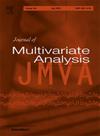Geometric scale mixtures of normal distributions
IF 1.4
3区 数学
Q2 STATISTICS & PROBABILITY
引用次数: 0
Abstract
Recently, Kundu (2017) proposed a multivariate skewed distribution, termed the Geometric-Normal (GN) distribution, by compounding the multivariate normal distribution with the geometric distribution. This distribution is a viable alternative to Azzalini’s multivariate skew-normal distribution and possesses several desirable properties. This paper introduces a novel class of asymmetric distributions by compounding the geometric distribution with scale mixtures of normal distributions. This class constitutes a special case of the continuous mixtures of multivariate normal distributions introduced by Arellano-Valle and Azzalini (2021). The proposed multivariate distributions exhibit high flexibility, featuring heavy tails, multi-modality, and the ability to model skewness. We have also derived several properties of this class and discussed specific examples to illustrate its applications. The expectation–maximization algorithm was employed to calculate the maximum likelihood estimates of the unknown parameters. Simulation experiments have been performed to show the effectiveness of the proposed algorithm. For illustrative purposes, we have provided one multivariate data set where it has been observed that there exist members in the proposed class of models that can provide better fit compared to skew-normal, skew-t, and generalized hyperbolic distribution. In another example, it was demonstrated that when data generated from a heavy-tailed skew-t distribution is contaminated with noise, the proposed distributions offer a better fit compared to the skew-t distribution.
正态分布的几何尺度混合
最近,Kundu(2017)将多元正态分布与几何分布相结合,提出了一种多元偏态分布,称为几何正态分布(GN)。该分布是Azzalini多元偏正态分布的可行替代,并具有几个理想的性质。本文将几何分布与正态分布的尺度混合复配,引入了一类新的不对称分布。该类构成了由Arellano-Valle和Azzalini(2021)引入的多元正态分布连续混合的特殊情况。所提出的多元分布具有高度的灵活性,具有重尾、多模态和对偏度建模的能力。我们还推导了这个类的几个性质,并讨论了具体的例子来说明它的应用。采用期望最大化算法计算未知参数的最大似然估计。仿真实验证明了该算法的有效性。为了说明问题,我们提供了一个多变量数据集,其中已经观察到,与斜正态分布、斜t分布和广义双曲分布相比,所提议的模型类别中存在可以提供更好拟合的成员。在另一个例子中,证明了当从重尾斜t分布生成的数据被噪声污染时,与斜t分布相比,所提出的分布提供了更好的拟合。
本文章由计算机程序翻译,如有差异,请以英文原文为准。
求助全文
约1分钟内获得全文
求助全文
来源期刊

Journal of Multivariate Analysis
数学-统计学与概率论
CiteScore
2.40
自引率
25.00%
发文量
108
审稿时长
74 days
期刊介绍:
Founded in 1971, the Journal of Multivariate Analysis (JMVA) is the central venue for the publication of new, relevant methodology and particularly innovative applications pertaining to the analysis and interpretation of multidimensional data.
The journal welcomes contributions to all aspects of multivariate data analysis and modeling, including cluster analysis, discriminant analysis, factor analysis, and multidimensional continuous or discrete distribution theory. Topics of current interest include, but are not limited to, inferential aspects of
Copula modeling
Functional data analysis
Graphical modeling
High-dimensional data analysis
Image analysis
Multivariate extreme-value theory
Sparse modeling
Spatial statistics.
 求助内容:
求助内容: 应助结果提醒方式:
应助结果提醒方式:


